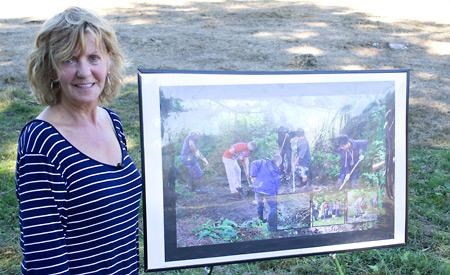Community volunteers and members of Royal Canadian Sea Cadet Corps Malaspina came together for a day of work with a plan to improve the population and health of wild salmon in Myrtle Creek.
Organized by Esther Dyck, who founded Myrtle Creek Stewards Society in 2009, the project centred on building a fish ladder which will allow wild coho salmon to lay their eggs farther up the creek.
“It’s natural for the coho to want to go as far up as they can,” said Dyck. “They were blocked, so this will help them get up a little farther.”
This project is the fifth year salmon habitat restoration work has been undertaken to improve Myrtle Creek. In years past work has focused on improving gravel spawning beds.
Dyck said last year, with the help of the cadets, more than 4,000 kilograms of mixed gravel was laid over two days of work.
“It was done with humour and respect,” she added. “I think they are just fabulous young people.”
Earlier this month, the cadets, with Dyck’s direction, helped clear the area around where the fish ladder on Tom and Elsie Parsons’ Claridge Road farm was to be reconstructed. They used an existing ladder that had been built at the location in the mid-1980s. They cut the cedar posts and reassembled the ladder with carriage bolts.
All the project’s building materials, as well as its labour, came from community donations.
“This project is helping us teach great environmental stewardship,” said Lieutenant Dave McLennan, commanding officer of the corps. “My cadets are learning all about how salmon spawn and how the work we’re doing is helping the fish.”
McLennan added that he seeks out projects like this each year because they help to teach the cadets about planning, responsibility and follow-through.
“What they learn here they can apply to anything they do and are good for developing citizenship,” he said.
The creek has long been recognized by both federal and provincial governments as well as the local community as critical salmon habitat in need of protection.
The creek is 14 kilometres long, from its source at West Lake to its estuary at Pebble Beach near Myrtle Rocks. Its length serves as spawning grounds for wild chum and coho salmon as well as many other varieties of aquatic life. It is not stocked with hatchery-grown fish and is home to sea-going cutthroat trout, lamprey eels and two species of sculpins, said Dyck.
Unlike other species of salmon, wild coho spend more than a year living in the creeks after they hatch before starting their journey to the ocean, she said. “That’s why it’s so important to look after a creek because there’s always wild juvenile coho in there.”
For 15 years she worked as a contractor for Department of Fisheries and Oceans (DFO) monitoring the creek and helping to take samples from the salmon. The data she helped to collect was used to monitor the freshwater and ocean survival rates of wild salmon. “I’m very passionate about wild coho,” she said.
She is one of few people who have surveyed the whole length of Myrtle Creek which has bestowed upon her an appreciation not only for the creek but also the salmon who perform great feats to ensure the survival of their species.
“I’m always pleased to see them return,” she said, adding that as soon as the water levels rise with the autumn rains the fish start making their way back. “They wait for a storm and higher water and then away they go. They are amazing.”



